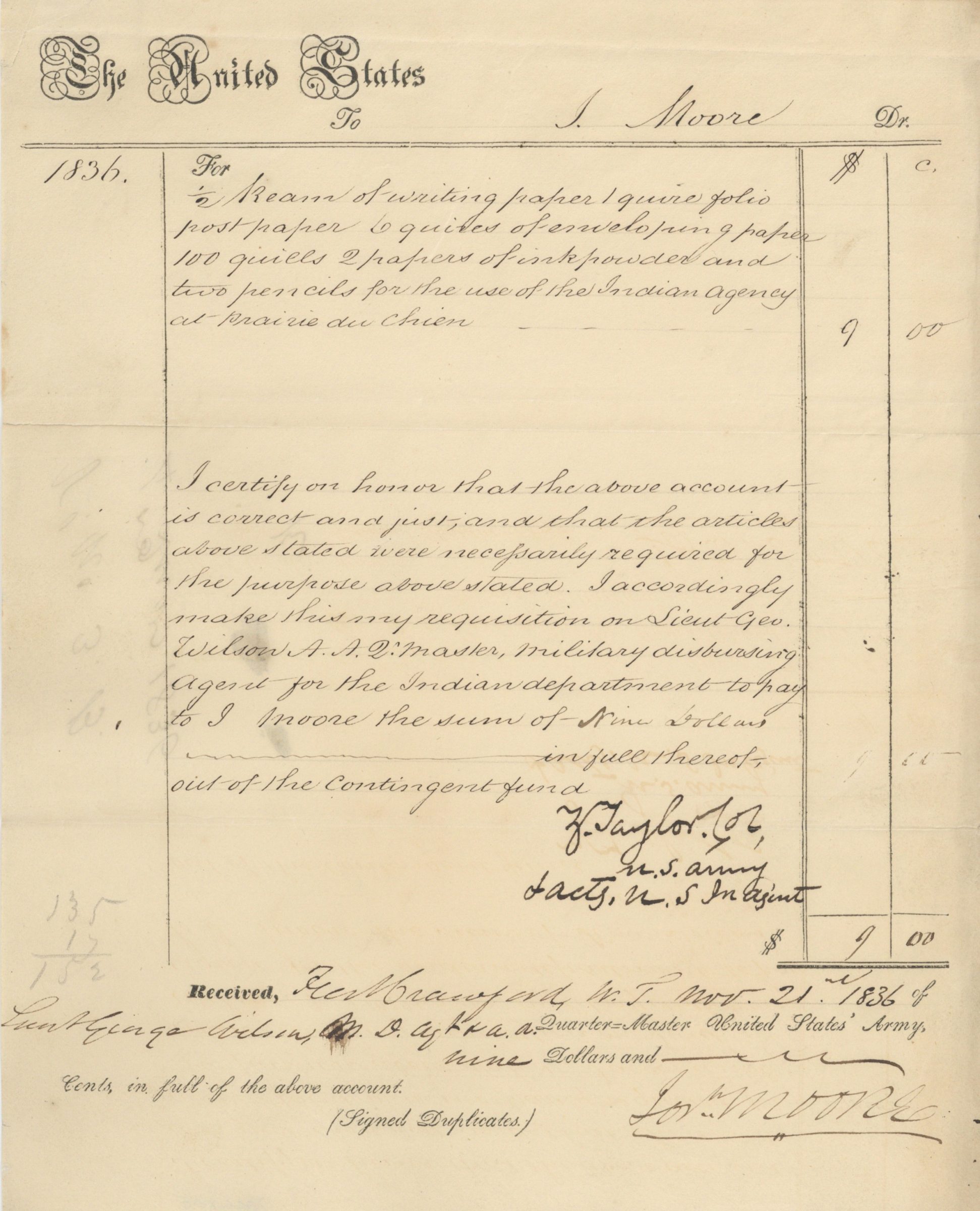Col. Zachary Taylor, in Command of Fort Crawford and in Charge of Its Indian Removal Responsibilities, Assists the Indian Agency There Obtain Supplies


Taylor first gained his reputation in battles against the Indians
- Currency:
- USD
- GBP
- JPY
- EUR
- CNY
Uncommon, the first document of its kind that we have carried
Fort Crawford stood guard over Prairie du Chien, Wisconsin, from 1816 until 1856. In the spring of 1829, troops began to build a new Fort Crawford on an elevated plain located on the mainland, safe from the floods that had plagued...
Uncommon, the first document of its kind that we have carried
Fort Crawford stood guard over Prairie du Chien, Wisconsin, from 1816 until 1856. In the spring of 1829, troops began to build a new Fort Crawford on an elevated plain located on the mainland, safe from the floods that had plagued the first fort. The new structure was built primarily with quarried limestone, and work progressed slowly. Colonel (and future president of the United States of America) Zachary Taylor took command of the construction in the summer of 1829, and commanded the fort from then until 1837. Jefferson Davis (later president of the Confederate States of America) was a lieutenant at Fort Crawford, and supervised work at a sawmill on the Yellow River that provided lumber for construction. Troops moved into the new barracks in December 1830. While at the fort, Davis met and fell in love with Taylor’s daughter, Sarah. They would marry in June 1835, making Zachary Taylor Jefferson Davis’s father-in-law. But tragedy awaited, as Sarah died three months into the marriage of yellow fever, devastating Davis and causing ill will with Taylor, who blamed Davis for taking his daughter into an unhealthy climate.
Soldiers at Fort Crawford served in many capacities after moving into the second fort. Most notably, troops took an active military role in forcing Native Americans west of the Mississippi River in accordance with the policies of President Andrew Jackson. Troops commanded by Col. Zachary Taylor fought in the Black Hawk War in 1832. On August 27 of that year, Black Hawk surrendered at Prairie du Chien and was jailed at the fort. In 1833, Lt. Jefferson Davis escorted Black Hawk to another prison at St. Louis, which journey also ended Davis’s time at Fort Crawford. The troops at Fort Crawford also worked to build a military road across Wisconsin to connect Fort Crawford with Fort Winnebago in Portage and Fort Howard in Green Bay. Additionally, soldiers from Fort Crawford enforced the relocation of the Ho-Chunk (Winnebago) Indians from Wisconsin to a reservation in Iowa in the 1830s. “Indian Removal,” as the government called it, disrupted lives across the region and was successful in transforming Prairie du Chien from the front lines of enforcing Indian policy to one well behind the lines, leaving Fort Crawford without much of its earlier significance. Soldiers only occupied the fort intermittently after 1849, and the last active troops withdrew from Fort Crawford on June 9, 1856.
The Prairie du Chien Indian Agency was active in the region at the same time as Fort Crawford. Its agents were appointed by the federal government and were in charge of relations with the Indians. The agents obtained supplies, settled disputes, paid annuities, and enforced treaty obligations. Fort Crawford was on site to assist the Indian Agency.
Document signed, Fort Crawford, November 1836, being a requisition and pay order for the agency’s supplies, signed by Taylor as the fort commander. “To J. Moore, 1836. For 1/2 ream of writing paper, 1 quire folio post paper, 6 quires of enveloping paper 100 quills, 2 papers of ink powder and two pencils for the use of the Indian agency at Prairie du Chien $9.00.” Below that is written “| certify on honor that the above account is correct and just; and that the articles above stated were necessarily required for the purpose above stated. | accordingly make this my requisition on Lieut. Geo. Wilson, A.A. Qr. Master, military disbursing agent for the Indian department to pay to J Moore the sum of nine dollars in full thereof out of the contingent fund.” It is signed “Z. Taylor. Col., U.S. Army and acting U.S. Indian Agent.”
Below that is Moore’s receipt for the $9.00. “Received, Fort Crawford, Wisconsin Territory, November 21, 1836, of Lieut. George Wilson, M D Agent & AA Quartermaster United States Army, nine dollars…Joseph Moore.”
An uncommon document. A search of public sale records going back 40 years indicates that the last document from Fort Crawford signed by Taylor reached that marketplace in 2005.

Frame, Display, Preserve
Each frame is custom constructed, using only proper museum archival materials. This includes:The finest frames, tailored to match the document you have chosen. These can period style, antiqued, gilded, wood, etc. Fabric mats, including silk and satin, as well as museum mat board with hand painted bevels. Attachment of the document to the matting to ensure its protection. This "hinging" is done according to archival standards. Protective "glass," or Tru Vue Optium Acrylic glazing, which is shatter resistant, 99% UV protective, and anti-reflective. You benefit from our decades of experience in designing and creating beautiful, compelling, and protective framed historical documents.
Learn more about our Framing Services










































































































